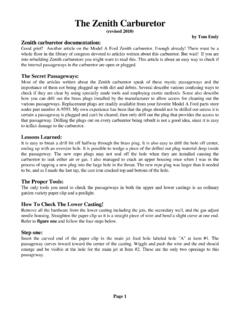Transcription of ENGINEERING SURVEYING (221 BE) Distance & Angle
1 ENGINEERING SURVEYING (221 BE) Distance & Angle Sr Tan Liat Choon Email: Mobile: 016-4975551 INTRODUCTION Types of Measurements in SURVEYING : SURVEYING is the art of making suitable measurements in horizontal or vertical planes. This is one of the important subjects of civil ENGINEERING . Without taking a survey of the plot where the construction is to be carried out, the work cannot begin 2 INTRODUCTION From the above definition, we conclude on two types of measurements in SURVEYING . They are as follows: Linear measurements Angular measurements 3 INTRODUCTION Linear measurements are further classified as follows: Horizontal Distance Vertical Distance 4 INTRODUCTION Horizontal Distance A horizontal Distance is measured in horizontal plane if a Distance is measured along a slope, it is reduced to its horizontal equivalent 5 INTRODUCTION Vertical Distance A vertical Distance is measured along the direction of gravity at that point.
2 The vertical Distance is measured to determine difference in elevations in various points 6 INTRODUCTION Angular Measurements Two sides meeting at an Angle are measured. The Angle between them is measured and represented in degrees or radians 7 Distance MEASUREMENT Linear measurement is the basis of all SURVEYING and even through angles may be read precisely, the length of at least one line in tract must be measured to supplement the angles in locating points 8 Distance MEASUREMENT Is generally regarded as the most fundamental of all SURVEYING observations Many angles may be read, the length of at least one line must be observed to supplement the angles in locating points In plane survey, the Distance between two points means the horizontal Distance 9 Distance MEASUREMENT Methods of measuring a horizontal Distance : Tacheometry (Stadia), Taping, EDM and GPS Distance from stadia.
3 (High wire Low wire) * 100 = Distance EDM & GPS are most common in today s survey Direct measurement Indirect measurement 10 Distance MEASUREMENT As simple as ABC: 11 New building site how big is it? m m m m Distance MEASUREMENT Measurement must be straight: 12 Distance MEASUREMENT Measurement around obstacle: 13 starting point closing point Obstacle to sight line Distance MEASUREMENT Measurement around obstacle: Horizontal angles and are used to transform the resulting horizontal lengths to an equivalent horizontal length along the measurement line H 2-4 = h 2-3 cos + h 3-4 cos 14 1 5 4 3 2 Distance MEASUREMENT Measurement must be straight: 15 Distance MEASUREMENT Measurement must be straight: 16 Distance MEASUREMENT Measurement must be straight: 17 Distance MEASUREMENT Generally, measurements are made horizontally, but on even, often man-made slopes the Distance can be measured directly on the slope, but the vertical or zenith Angle must be obtained V = Vertical Distance S = Slope Distance H = Horizontal Distance 18 A S V H B C Distance MEASUREMENT c2 = a2 + b2 C = 90 = A + B sin A = a/c cos A = b/c tan A = a/b 19 A c a b B C Distance MEASUREMENT A + B + C = 180 Sine Rule: a/sin A = b/sin b = c/sin C Cosine Rule: a2 =b2 + c2 2bc cos A cos A = (b2 = c2 - a2)/2bc Area = 1/2 bc sin A = s(s - a) (s - b) (s c) where s = (a + b + c)/2 20 A c b a B C INTRODUCTION ON Angle MEASUREMENT Measuring distances alone in SURVEYING does not establish the location of an object.
4 We need to locate the object in 3 dimensions. To accomplish that we need: Horizontal length ( Distance ) Difference in height (elevation) Angular direction 21 INTRODUCTION ON Angle MEASUREMENT Angles measured in SURVEYING are classified as either horizontal or vertical, depending on the plane in which they are observed Horizontal angles are the basic observations needed for determining bearing and azimuths Vertical angles are used in trigonometric levelling stadia and for reducing slope distances to horizontal 22 INTRODUCTION ON Angle MEASUREMENT Determining the locations of points and orientations of lines frequently depends on measurements of angles and directions In SURVEYING , directions are given by azimuths and bearings 23 INTRODUCTION ON Angle MEASUREMENT An Angle is defined as the difference in direction between two convergent lines A horizontal Angle is formed by the directions to two objects in a horizontal plane A vertical Angle is formed by two intersecting lines in a vertical plane, one of these lines horizontal A zenith Angle is the complementary Angle to the vertical Angle and is formed by two intersecting lines in a vertical plane, one of these lines directed toward the zenith 24 INTRODUCTION ON Angle MEASUREMENT 25 TYPE OF Angle MEASUREMENT Interior angles are measured clockwise or counter-clockwise between two adjacent lines on the inside of a closed polygon figure Exterior angles are measured clockwise or counter-clockwise between two adjacent lines on the outside of a closed polygon figure Deflection angles.
5 Right or left, are measured from an extension of the preceding course and the ahead line. It must be noted when the deflection is right (R) or left (L) 26 TYPE OF Angle MEASUREMENT Angles to the right are turned from the back line in a clockwise or right hand direction to the ahead line Angles to the left are turned from the back line in a counter-clock wise or left hand direction to the ahead line Angles are normally measured with a transit or a theodolite, but a compass may be used for reconnaissance work 27 TYPE OF Angle MEASUREMENT 28 Angle MEASUREMENT Angle is a difference in direction of 2 lines To turn an Angle we need a reference line, direction of turning and angular Distance Angular units: Degree, minutes, second Circle divided into 360 degrees Each degree divided by 60 minutes Each minute divided into 60 seconds A check can be made because the sum of all angles in any polygon must equal.
6 (n-2) * 180, where n is the number of angles 29 MEASURING HORIZONTAL Angle Set a bearing on the horizontal plate, and lock the upper motion Release the lower motion, sight the backsight, lock the lower motion, and perfect the sighting with the lower tangent screw Release the upper motion, turn to the foresight, lock the upper motion, and perfect the sighting Record the horizontal bearing Release the lower motion, invert the scope and point to the backsight in the reverse position, lock the lower motion, and perfect the sighting Release the upper motion, turn to the foresight, lock the upper motion, and perfect the sighting Record the second bearing 30 MEASURING zenith Angle Point the instrument to the target object in a direct position Lock the vertical motion, perfect the sighting and record the zenith Angle Loosen both the horizontal and vertical motions, plunge the scope, rotate the alidade 180 and re-point to the target in the reverse position Lock the vertical motion, perfect the pointing and record the zenith Angle 31 MEASURING zenith Angle Direct 83 28 16 Reserve 276 31 38 Sum 359 59 54 360 Minus Sum 00 00 06 Half Value (error) 00 00 03 Plus Original Angle 83 28 16 Final Angle 83 28 19 32 USEFUL CONCEPTS Degrees: full circle = 360 0 45 90 135 180 225 270 315 33 USEFUL CONCEPTS 34 BEARING AND AZIMUTH 35 COMPARISON OF AZIMUTH AND BEARING Because bearings and azimuths are encountered in so many SURVEYING operations, there is important to know the conversion of these two.
7 Example 1 The azimuth of a boundary line is 128 13 46 . Convert this into bearing. The azimuth places the line in the southeast quadrant. Thus the bearing Angle is: 180 13 46 - 128 13 46 = 51 46 14 , and the equivalent bearing is S 51 46 14 E Example 2 The first course of a boundary survey is written as N 37 13 W. What is its equivalent azimuth? Since the bearing is in the northwest quadrant, the azimuth is: 360 - 37 13 = 322 47 36 COMPARISON OF AZIMUTH AND BEARING 37 Azimuths Bearings Vary from 0 to 360 Vary from 0 to 90 Require only a numerical value Require two letters and a numerical value May be geodetic, astronomic, magnetic, grid, assumed, forward or back May be geodetic, astronomic, magnetic, grid, assumed, forward or back Are measured clockwise only Are measured clockwise and counterclockwise Are measured either from north only, or from south only on a particular survey Are measured from north and south COMPARISON OF AZIMUTH AND BEARING 38 Quadrant Formulas for computing bearing angles from azimuths I (NE) Bearing = Azimuth II (SE) Bearing = 180 - Azimuth III (SW) Bearing = Azimuth - 180 IV (NW) Bearing = 360 - Azimuth COMPARISON OF AZIMUTH AND BEARING 39 Example directions for lines in the four quadrants (Azimuths from north)
8 Azimuths Bearings 54 N 54 E 112 S 68 E 231 S 51 W 345 N 15 W AZIMUTH 40 Line Azimuth O A 54 O B 133 O C 211 O D 334 COMPUTING AZIMUTH 41 N B A C N COMPUTING AZIMUTH 41 35 = AB + 180 00 221 35 = BA + 129 11 350 46 = BC - 180 00 170 46 = CB + 88 35 259 21 = CD - 180 00 79 21 = DC + 132 30 211 51 = DE 42 211 51 = DE - 180 00 31 51 = ED + 135 42 167 33 = EF + 180 00 347 33 = FE + 118 52 466 25 - 360 = 106 25 = FA + 180 00 286 25 = AF + 115 10 401 35 - 360 = 41 35 = AB When a computed azimuth exceeds 360 , the correct azimuth is obtained by merely subtracting 360 BEARING 43 Line Bearing O A N 54 E O B S 47 E O C S 31 W O D N 26 W COMPUTING BEARING 44 Line Bearing AB N 25 W BC N 68 E CD S 17 W DA S 62 W BEARING Bearing of a line is the direction of the line Azimuth of a line is the horizontal Angle between 2 lines Designation of Bearings Whole circle bearing Reduced Bearing (RB) or quadrantal bearing (QB) Fore Bearing (FB) or forward bearing (FB) Back bearing or Backward bearing (BB)
9 Calculated bearing Whole Circle bearing Bearings measured from north in a clockwise direction is termed as whole circle bearing The value varies from 0 degrees to 360 degrees Reduced bearing/Quadrantal bearing The bearings measured either from the north or from the south towards east or west whichever is nearer is known as reduced bearing The values vary from 0 degrees to 90 degrees for a particular quadrant It is also known as quadrantal bearing (QB) 45 BEARING Fore Bearing (FB) The bearings measured in the progress of SURVEYING in the forward direction of survey lines is known as fore bearing or forward bearing Back Bearing (BB) The bearings measured in opposite to the progress of SURVEYING in backward direction of survey line is known as Backward Bearing Observed Bearing The bearings taken in a field with an instrument is known as Observed Bearing Calculated Bearing The bearings calculated from the field observation is known as calculated bearing 46 RECTANGULAR COORDINATE 47 POLAR COORDINATE 48 +P (r, ) y x r u P (x,y) y x Cartesian coordinates Perpendicular axes Origin at (0,0) Coordinates increase right & up of origin Coordinates decrease down & left of origin (0,0) x + + - - COORDINATE IN A PLANE 49 Cartesian coordinates Coordinates of point given by bracketed pairs of numbers.
10 (right,up) (0,0) x (3,4) x (-3,-2) x (x,y) (Easting,Northing) -depending on coordinate system used COORDINATE IN A PLANE 50 Often easier to avoid negative values by increasing origin coordinates + + (1000,1000) x (1004,1006) x (1001,1002) x (998,999) x NOTE: Some countries (incl. Sweden) use on maps: y=East x=North Others use opposite ( (England, USA) We ll use (Easting,Northing) COORDINATE IN A PLANE 51 p0 x p1 x Find coordinates of p1 in relation to p0 Easting Northing FINDING COORDINATE 52 p0 x p1 x Reference bearing (N) Instrument p0 (instrument) has known coordinates (0,0) for the moment reference bearing is known (N) p1 has a unknown coordinates FINDING COORDINATE 53 Northing = d cos( ) Easting = d sin( ) Use instrument to measure: d = (horizontal) Distance p0-p1 = Angle between North & bearing of p1 from p0 p0 p1 x Reference bearing (N) = bearing from reference d = Distance from p0 to p1 d with Polar Coordinates FINDING COORDINATE 54 Northing = d cos( ) Easting = d sin( ) p0 x p1 x Reference bearing (N) d 10m Easting = d sin( ) = 10 sin( ) = 10* = 6m Northing = d cos( ) = 10 cos( ) = 10* = 8m also called the azimuth FINDING COORDINATE 55 Northing = d cos( ) Easting = d sin( ) p0 x p1 x Reference bearing (N) d 10m (6,8) p1(Easting) = p0(Easting) + (d sin( )) p1(Northing) = p0(Northing) + (d cos( )) So if p0=(1000,1000) then p1(Easting,Northing) = (1006,1008) FINDING COORDINATE 56 SURVEYING COORDINATE 57 For SURVEYING we use a slightly different form of notation, instead of x, y, +P ( E, N) N E D u We use E, N (Easting, Northing) SURVEYING COORDINATE Note.)






